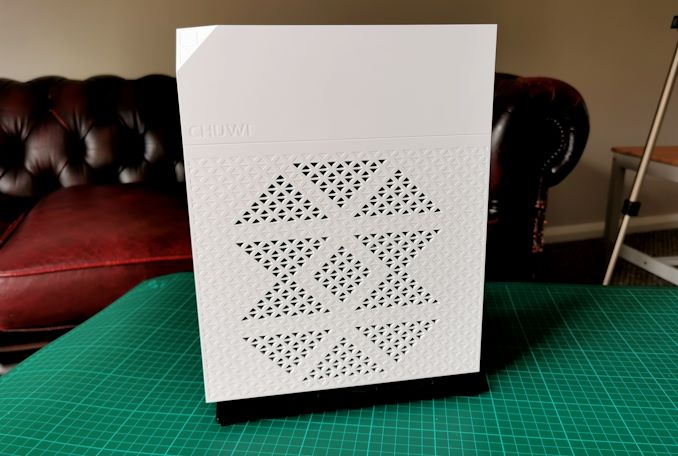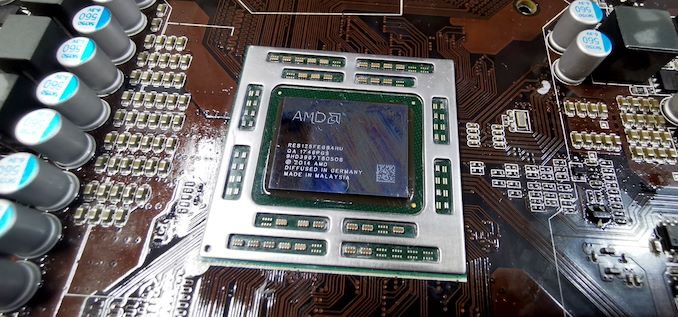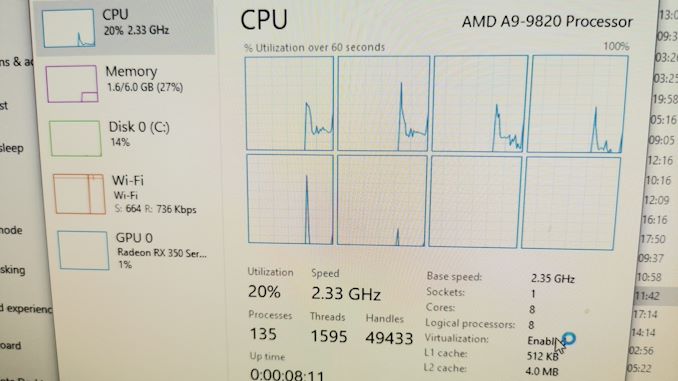Installing Windows on an Xbox One APU: The Chuwi Aerobox Review
by Dr. Ian Cutress on December 24, 2020 9:45 AM ESTWindows on Consoles: One Step Forward
As a semiconductor enthusiast, getting a chance to test the esoteric options on the market is always a delight. Gaming consoles, especially those that are x86 based, offer a unique insight into the effect of what a large combined CPU+GPU can bring to the market, assuming it has sufficient memory bandwidth, but because of the semi-custom nature of the agreement between AMD and Sony/Microsoft, actually getting to run any decent tests on them has been an idea that stopped before it started. Now that we’re transitioning from one generation of consoles to another, it appears that at least some of that shroud has been lifted, and companies like Chuwi are able to take advantage of silicon coming onto the market to build their own designs, based on operating systems that can offer a deep level of customizability.
So here we have the Chuwi Aerobox, built using a processor now known as the A9-9820. This processor is a fully enabled Xbox One ‘Durango+’ processor, which I’ve labelled as Edmonton+. It offers eight Jaguar cores at 2.35 GHz, which is +650 MHz above the Xbox One, and all 896 graphics cores built into the silicon are enabled, compared to only 768 for the Xbox console. It uses dual-channel DDR3-1333, and the only thing missing is eSRAM access.
Poking the console has exposed that MSI is the ODM here, although it remains unclear whether it is MSI, Chuwi, or someone else actually sourcing the silicon (and exactly from where). Chuwi pairs the APU with 8 GB of DDR3, two of which goes to the graphics and six goes to the Windows 10 Home installation. Unfortunately this runs at a fraction of the bandwidth (14 GB/s vs 200+ GB/s) to the console equivalents.
For the Aerobox, Chuwi includes a very beefy cooler, which is very quiet and keeps the system well within any thermal limits. The only downside is the slapdash job in which Chuwi applied thermal paste, accounting for the worst experience in a pre-built PC I’ve ever seen. We applied our own paste, dropped the temperatures a little, and slept a little easier (see here for a cool video montage).
On the plus side to Chuwi, they do equip the system with a 256 GB M.2 SATA SSD, eschewing any spinning rust option, and there’s a space inside for a user to put their own 2.5-inch SATA drive for storage. Modern games require modern storage solutions, and Chuwi has left options, which is a good thing. Annoyingly however, the build quality is such that we broke our power button when opening the chassis to install a drive, so your mileage may vary. In another nod to some lacking quality assurance, the Wi-Fi module was in its own M.2 slot, but rather than being screwed in (with a screw header even present on the board), it was glued on.
All the connectivity is on the rear, which is a shame, because I would have liked at least two USB ports on the front. On the back we get only two USB 3.0 as our fastest IO, which is a product of this generation of APU. The fact that the video output is only DVI-D is disappointing, but Chuwi supplies a DVI-D to HDMI cable in the box – it’s just that it’s a short cable requiring close proximity to the display.
On the performance side, we have a mixed bag. It ultimately performs worse than the equivalent consoles of its era because we’re using Windows rather than the optimized software stack that consoles use, allowing for deeper optimization. The older generation Jaguar cores are technically from 2013, and likely started design around 2009-2010, and are quite far removed from the modern core feature set. So despite there being eight cores on here, and clocking at 2.35 GHz which is near the peak for a Jaguar core ever, anything beyond the simplest CPU workloads is going to chug. The SSD helps a lot here, but rapid switching between applications in a modern office workflow does become apparent. For video playback on YouTube, 4K30 had zero dropped frames, but going beyond that caused a fair amount of stutter.
On the gaming side, for any titles aside from the basic eSports ones, then users will have to learn to expect around a 30 FPS average at low settings. This means that this might make a nice eSports box, however I was happy to play Borderlands 3, albeit at 720p Low, at a 30 FPS average. Emulation of mid-range platforms won't be so great, given the low score in our Dolphin test, but you should be able to get up to the Wii.
The biggest deficit in gaming here is going to be that because this is recognized as a non-standard graphics card, some games won’t run because of that, but also that there will be zero driver updates, and standard drivers won’t work. There are hurdles to get through, and Chuwi would be a big help here if they offered a driver kit to download directly, rather than enthusiasts having to use a VPN to access one of MSI’s sub-contractors.
Overall it’s a very interesting little box, and I’m really glad that these old console processors are seeing the light of day in a different style of design. Due to their age, there isn’t a lot you can do with them, but for specific tasks it can do the job. Chuwi gets plus points for the cooling solution, and enabling a SATA SSD in the model, however there are substantial quality assurance issues that need addressing, like the thermal paste, the glue, and the breakable chassis. This doesn’t jive with some of the other Chuwi products I’ve used in the past, which makes me suspect this might have been an early sample.
We’re not sure exactly what the Aerobox will be sold for in Japan, but from a hardware and performance standpoint, we could see it fitting in just above our standard CPU guide $300-$500 system brackets. I have to consider, at the $500 price point, would I suggest someone build a system with something like a Ryzen 5 3400G instead? I probably would. But at the $300 price point, as a fully contained system, the Chuwi can be competitive, simply because it's a fully contained system that can play Borderlands 3. This is even despite some of the driver/performance issues.
Nonetheless, it looks like Chuwi won’t be selling these outside of the Japanese market any time soon.
Options For Outside Japan
Users outside Japan that are interested in playing with an old Xbox One APU like this can turn to Aliexpress, where a vendor has motherboards available equipped with this APU. You can get the board shipped for $125, and it comes with a cooler using the standard Intel LGA115x mounting, as well as a backplate. Note that import duties may apply depending on your region, as these come from China.
Naturally, I purchased one for myself, as I like to collect these things. It is shown here on the left, compared to Chuwi Aerobox on the right.
There are some slight differences – the power delivery is different, there are four SATA ports rather than two, the rear has HDMI rather than DVI-D, but there is not spot for an M.2 Wi-Fi module. The Aliexpress one on the left also only has a 4-pin power connector, and only two 4-pin fan headers. One of the USB headers on the bottom isn’t their either. I know some users who have purchased these with differing results – one had a board with a lower grade processor (the RX-8120), another was DOA, and of course there is no warranty on these things. Mine is still a work in progress. Though based on the APU markings, my processor seems to be of the same batch as the Aerobox. It looks like I have a project for the holidays.
















101 Comments
View All Comments
Oxford Guy - Friday, December 25, 2020 - link
Don’t forget Sony, the company that advertised the ability to run Linux on the PS3 to sell them and then yanked away the ability. Then, in court, the company tried to call the plaintiffs bad apple ‘nobodies’. The company argued that ‘no one’ had any interest in running Linux on the machines — of course after the military among others did exactly that. A relentless patterns of bad faith from a corporation? Perish the thought.osx86h3avy - Saturday, December 26, 2020 - link
My understanding was allowing Linux was a knee jerkmreaction to the og Xbox being hacked to run Linux et al,and Sony was like "pfft, yall want it we will give it to ya" in a sort of bad faith way originally.....not that it makes it ok to then drop support later like they did but it always struck me as more of a fu to m$ than serious consideration for the communityOxford Guy - Saturday, December 26, 2020 - link
Sony chose to make effort to advertise the feature. It wasn't just listed in small print.Sony then pulled a bait and switch. I think I heard the suggestion that it was done as a way to protect BluRay discs from being ripped. Regardless of the reason, Sony had no legal or ethical way to cut a feature out of the product it had sold to people. It's like the scandal of e-book providers reaching into your device to delete books you purchased.
Lord of the Bored - Saturday, December 26, 2020 - link
To my recollection, it was for tax purposes. It let them call it a computer rather than a game console in some regions.Rookierookie - Saturday, December 26, 2020 - link
Microsoft obviously doesn't want to affect the Windows PC market.Sony, though, I don't know. They sell PCs, yes, but I don't know if VAIO is big enough that Sony would actually be harmed if they enabled the capability on their consoles. They've also done something similar before, by making the PS2 a DVD player as well.
Oxford Guy - Saturday, December 26, 2020 - link
Microsoft obviously wants to have its cake (a "console" it can make money on) and eat it, too (Windows PC gaming).Too bad the public isn't smart enough to say no and demand a common software layer (Vulkan + OpenGL) to go with the common hardware layer (x86).
Alexvrb - Friday, December 25, 2020 - link
This would have made *SOME* sense if it was released years ago and used faster DDR3 in a quad channel configuration like the consoles themselves. Even better if they had worked with AMD to enable the eSRAM but that's a long shot for a niche APU. The actual configuration used is just awful for anything other than dumping old stock of DDR3.At least we are finally seeing a similar cache used to good effect on PC with the RX 6000 series.
eastcoast_pete - Friday, December 25, 2020 - link
Now I know they aren't really directly comparable, but how much better or faster is this setup when compared with, let's say, a Snapdragon 865+ based gaming smartphone like the Asus ROG III? Is there a way to run Aztec Ruins or whatever on this Chuwi box, just to get an idea? My strong suspicion is that the gaming smartphone will actually hold its own.B3an - Saturday, December 26, 2020 - link
I've love to see this compared to high-end phone SoC's from the last few years. I've been saying all this time that they've been faster than the base XO console for a long time now.lmcd - Monday, December 28, 2020 - link
The SRAM cache enables nearly double the memory bandwidth in scenarios that are apparently very important and/or very common, so it's not a small thing to gloss over. And likewise this isn't a platform Windows is at all optimized for. I agree that in CPU-bottlenecked scenarios you're clearly right but it's pretty easy to push a videogame toward GPU-bottlenecked imo.